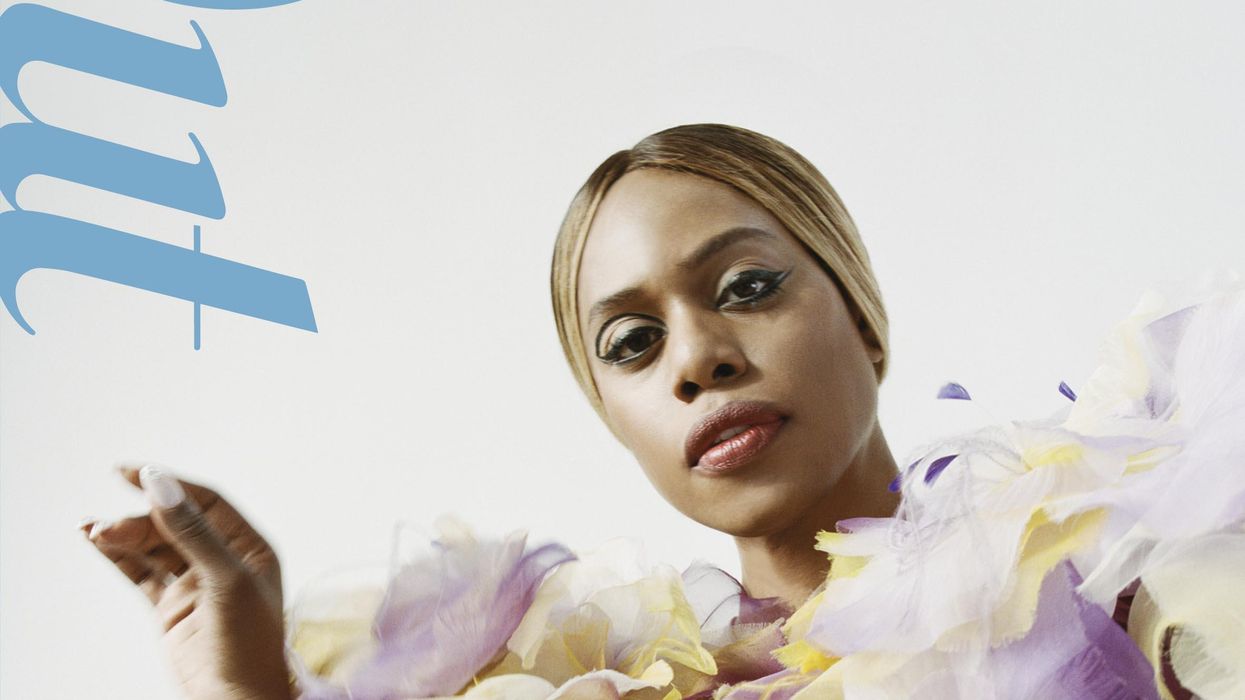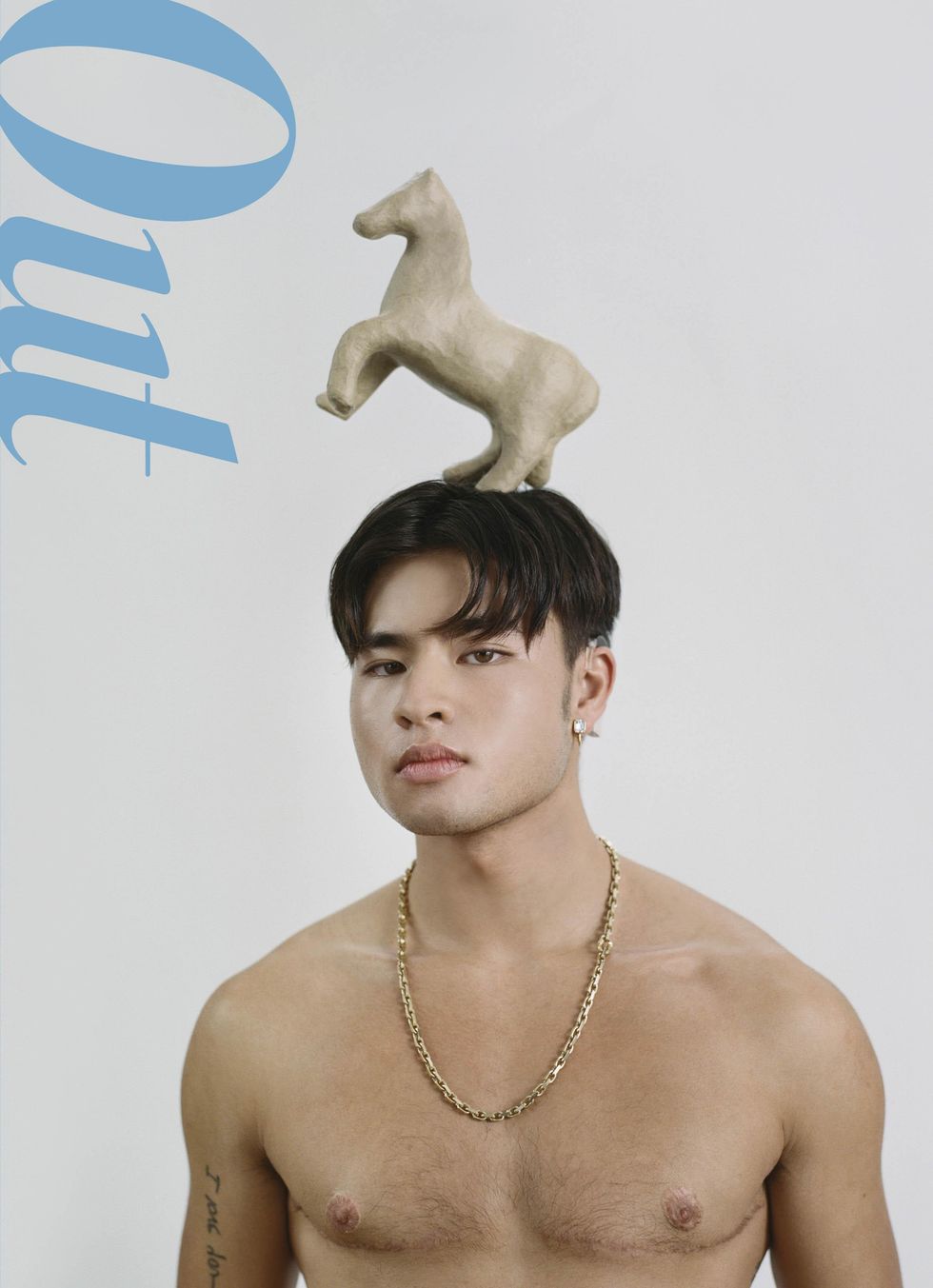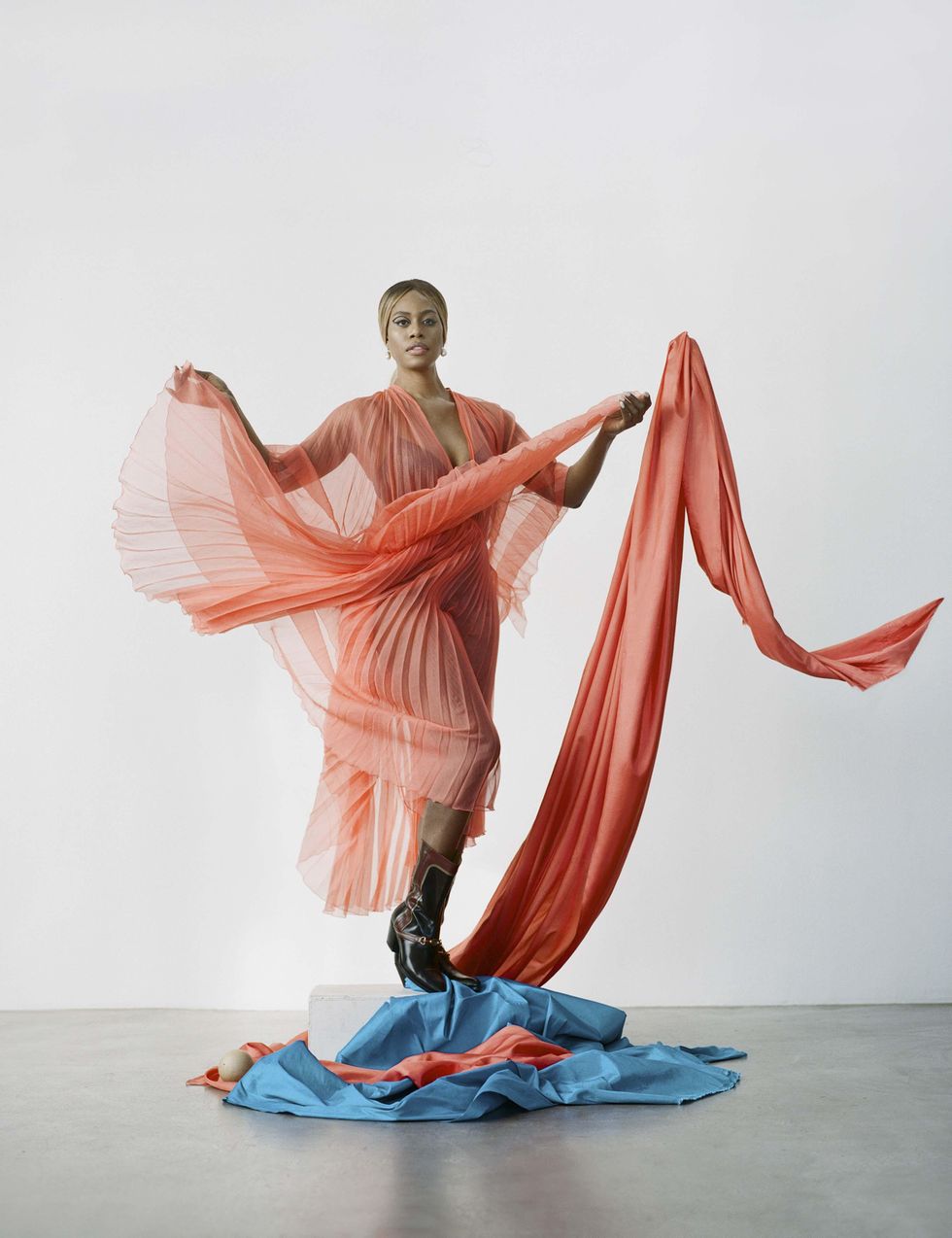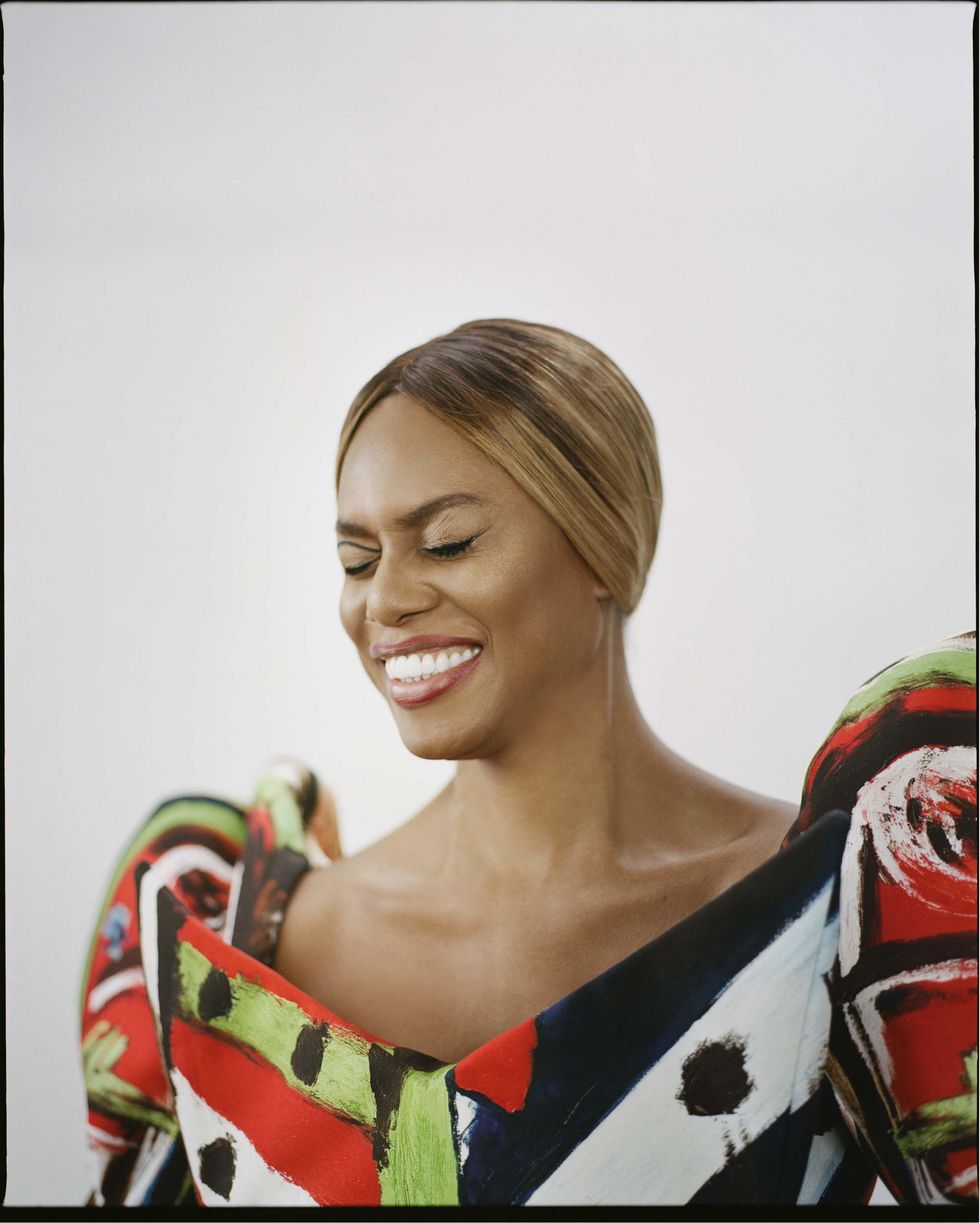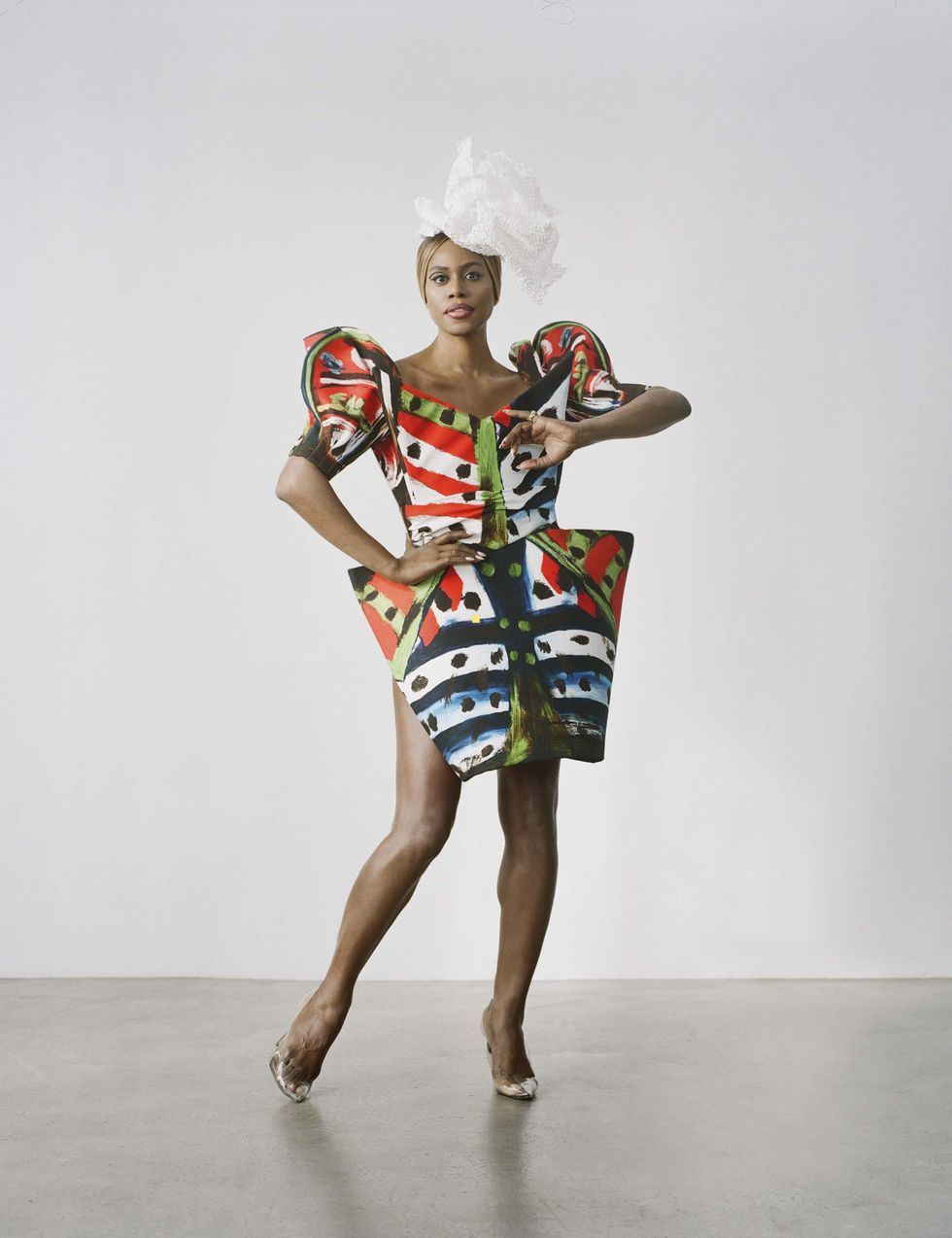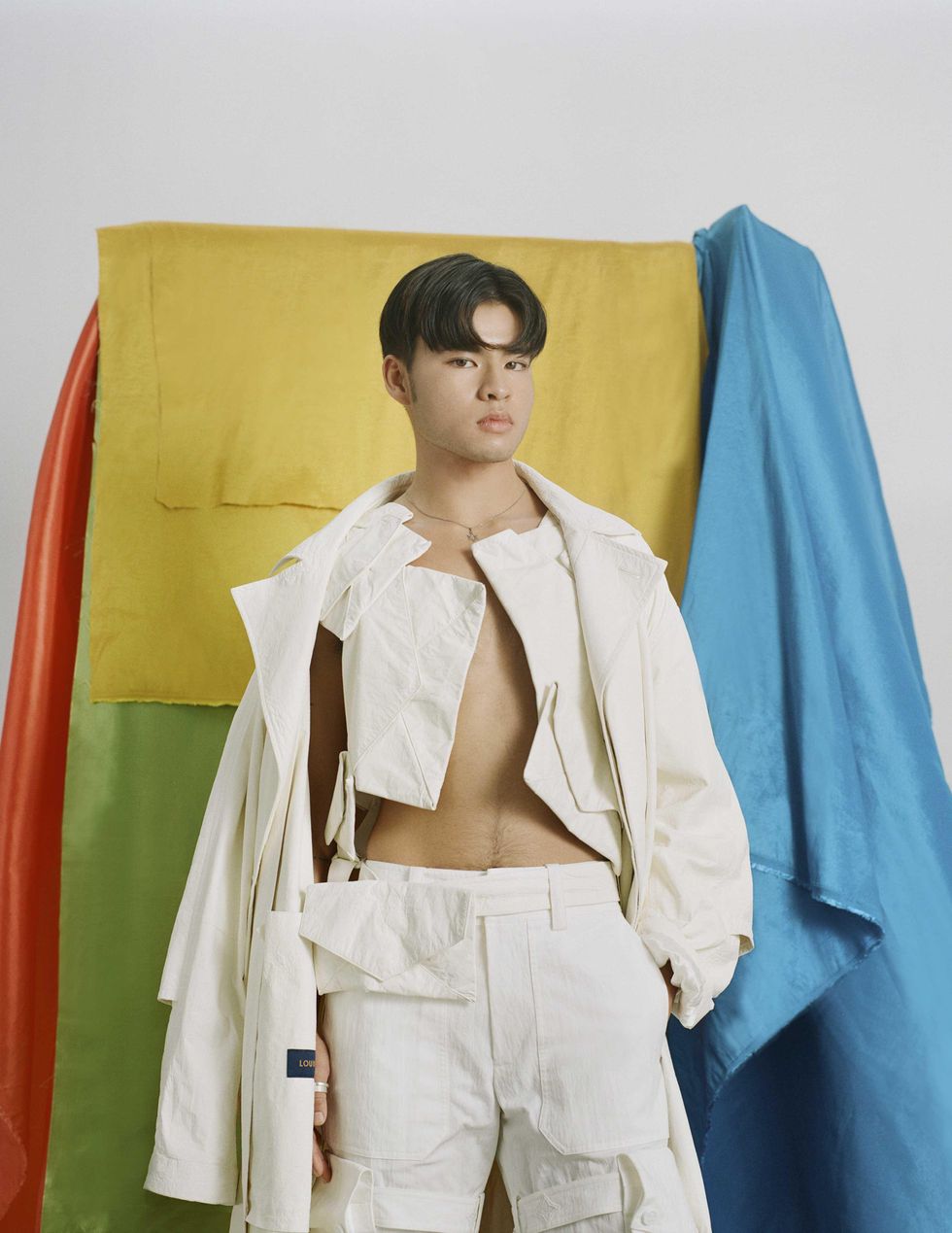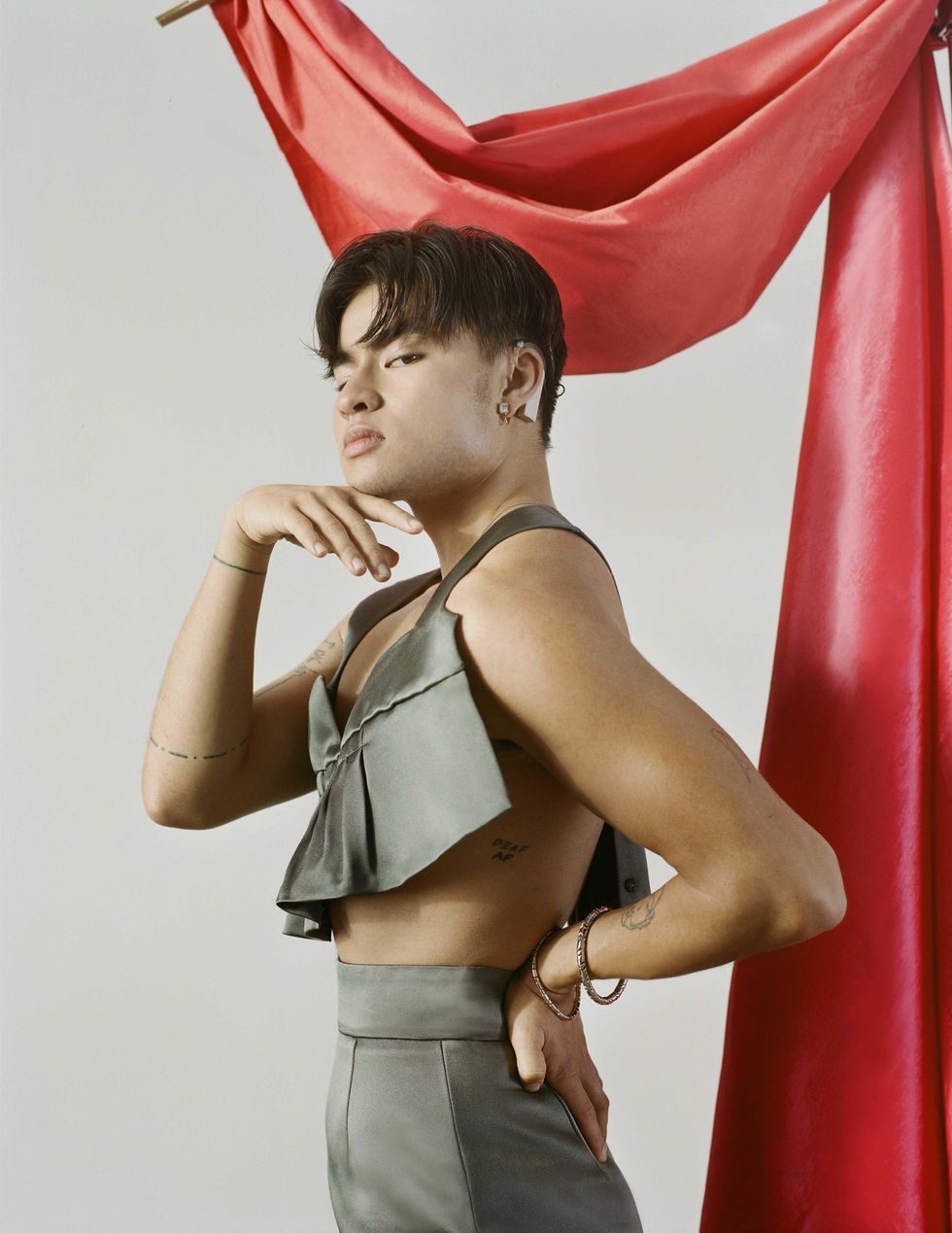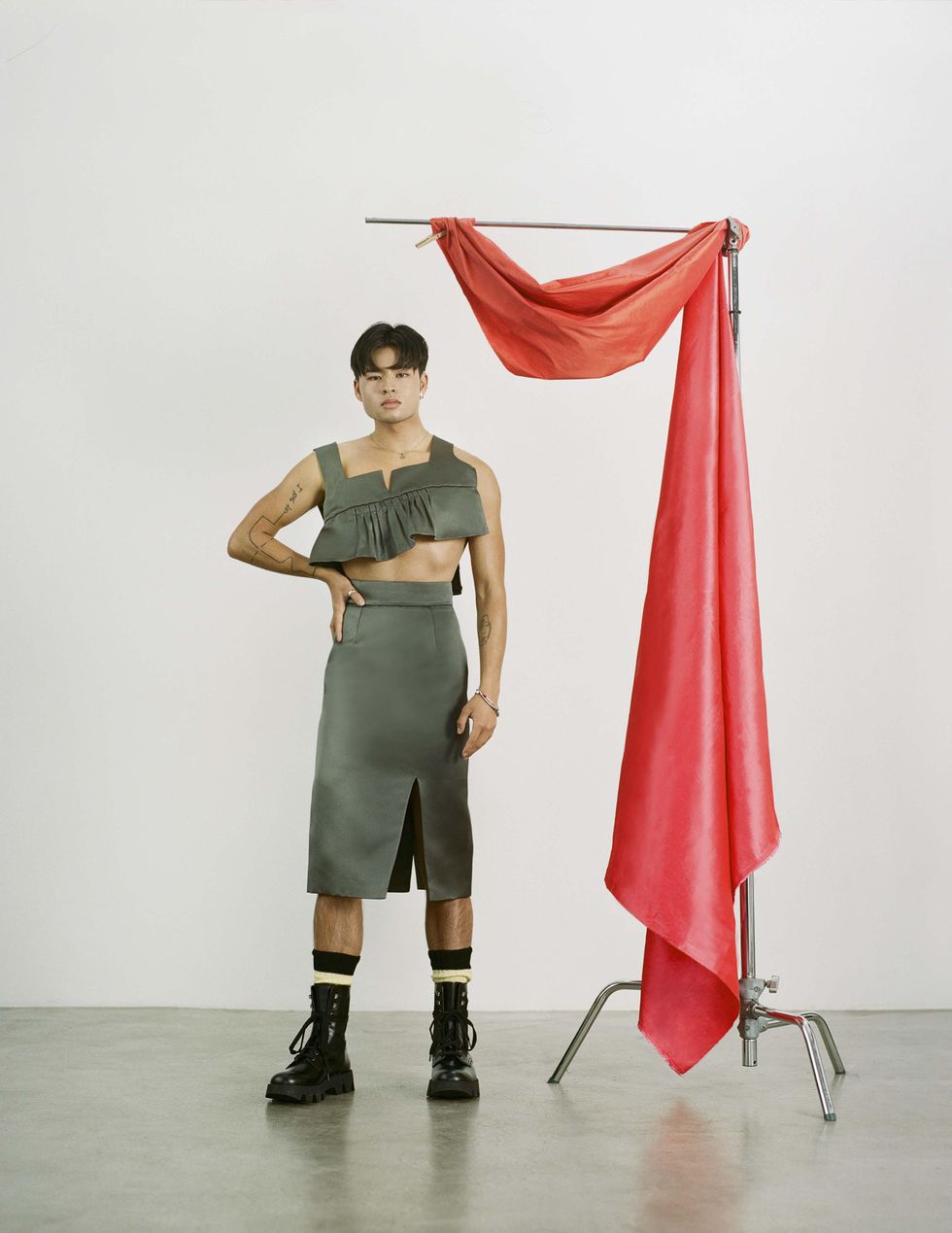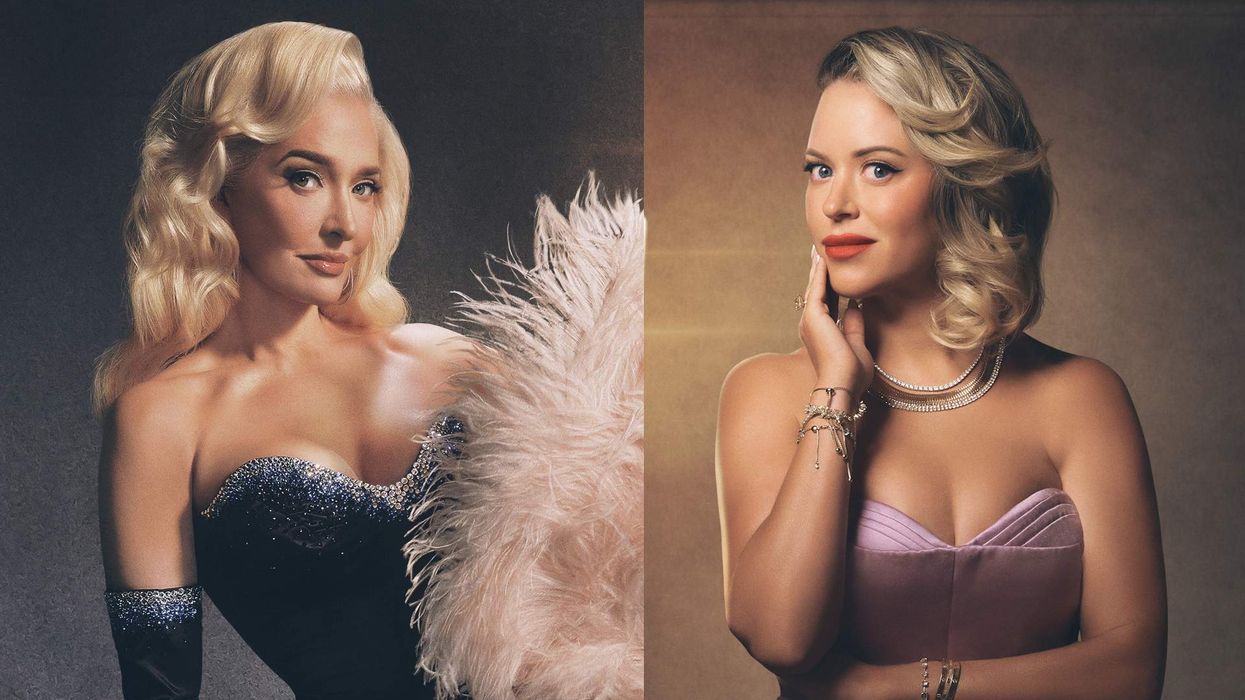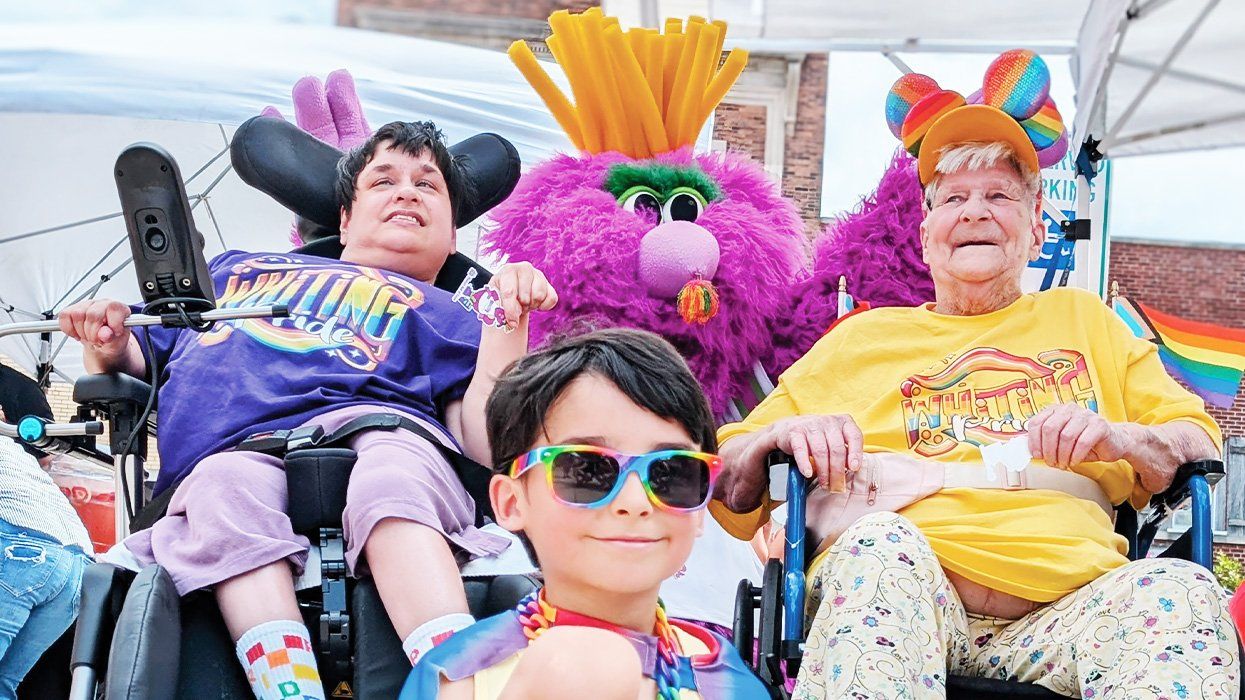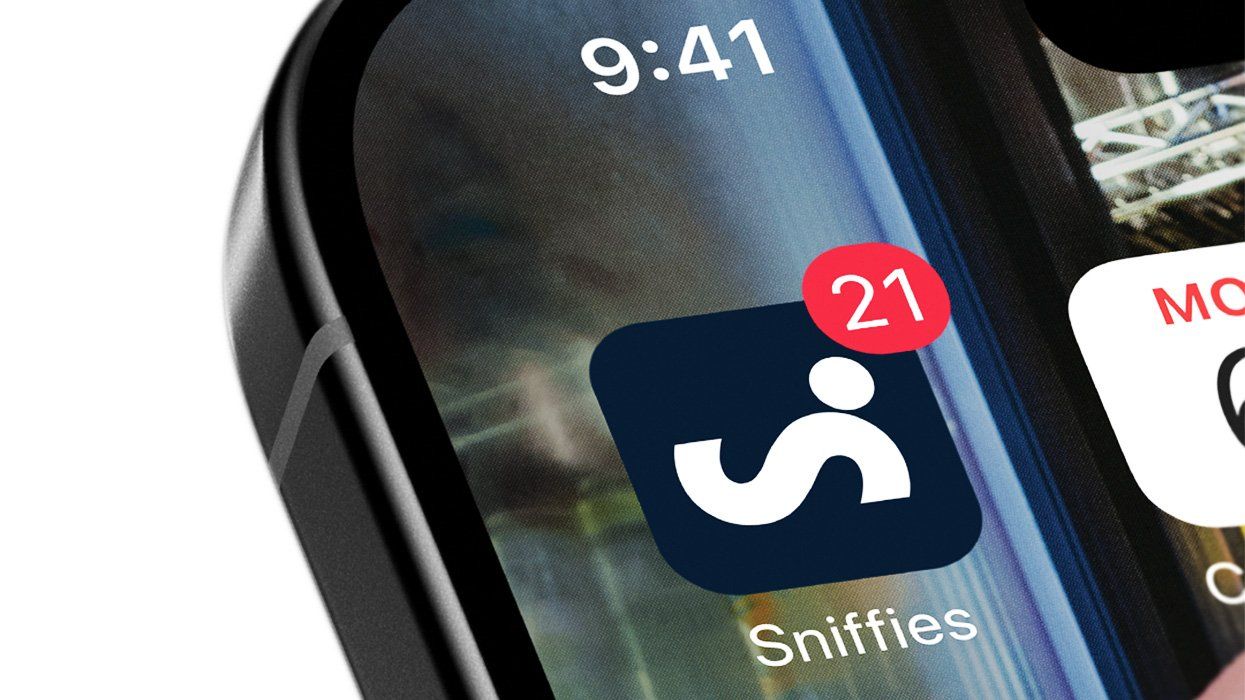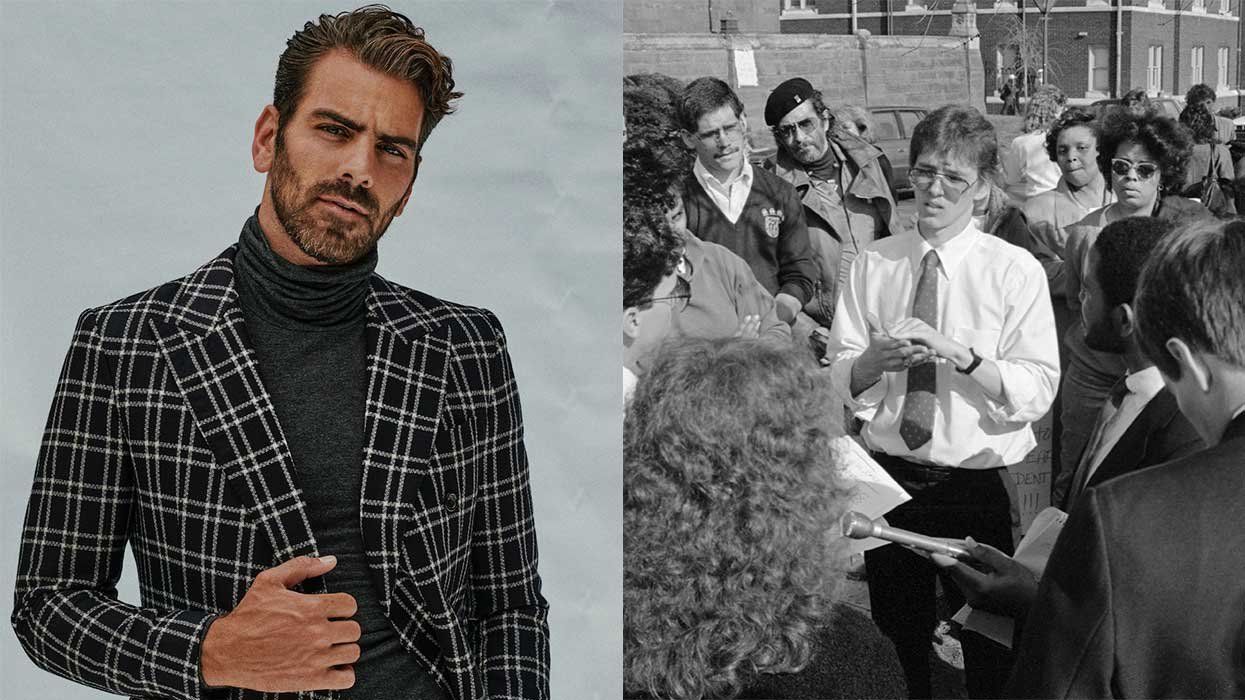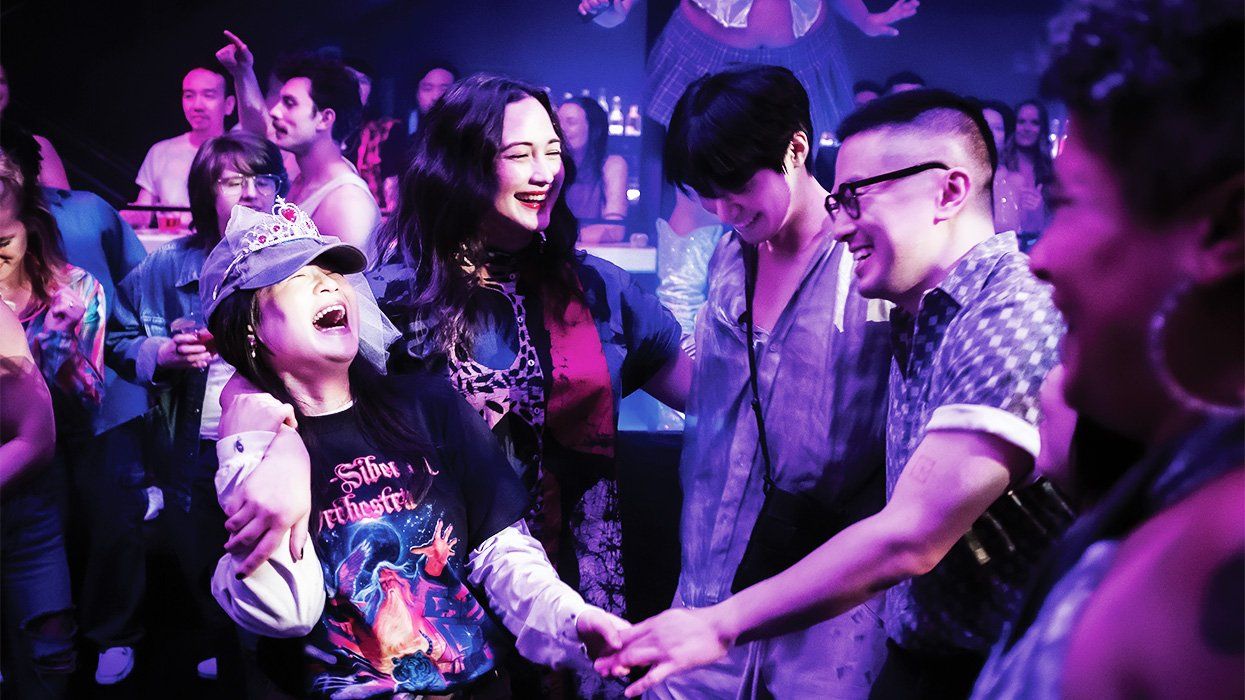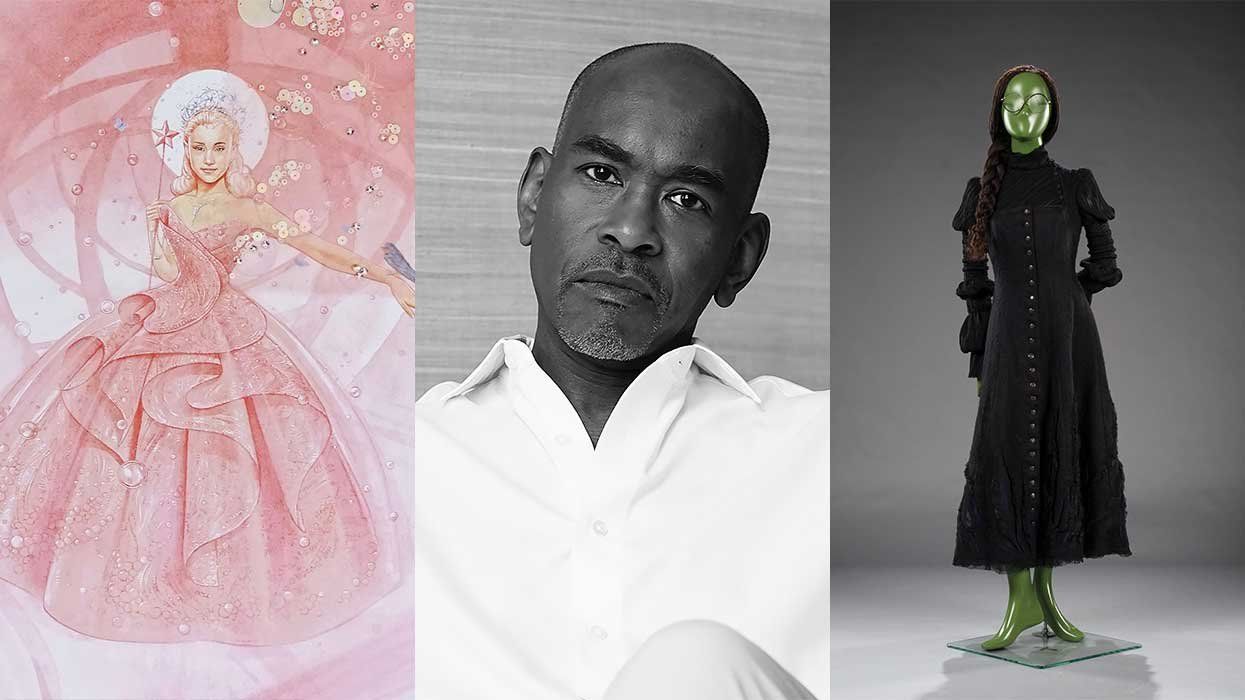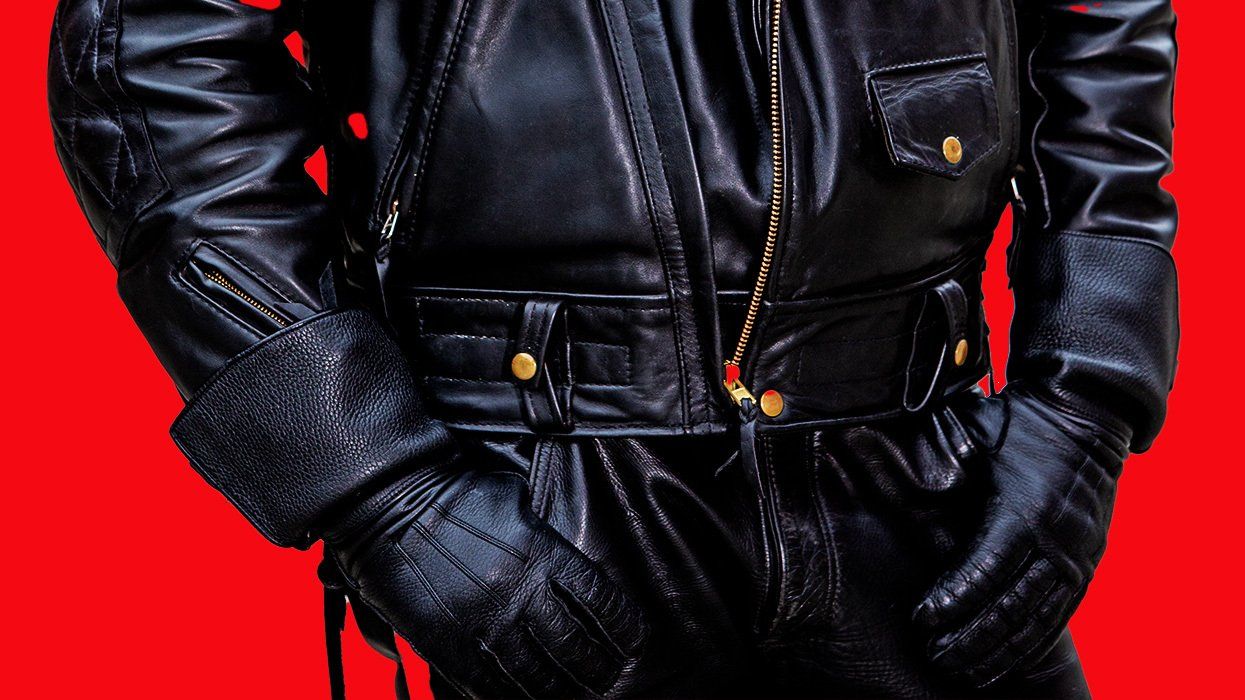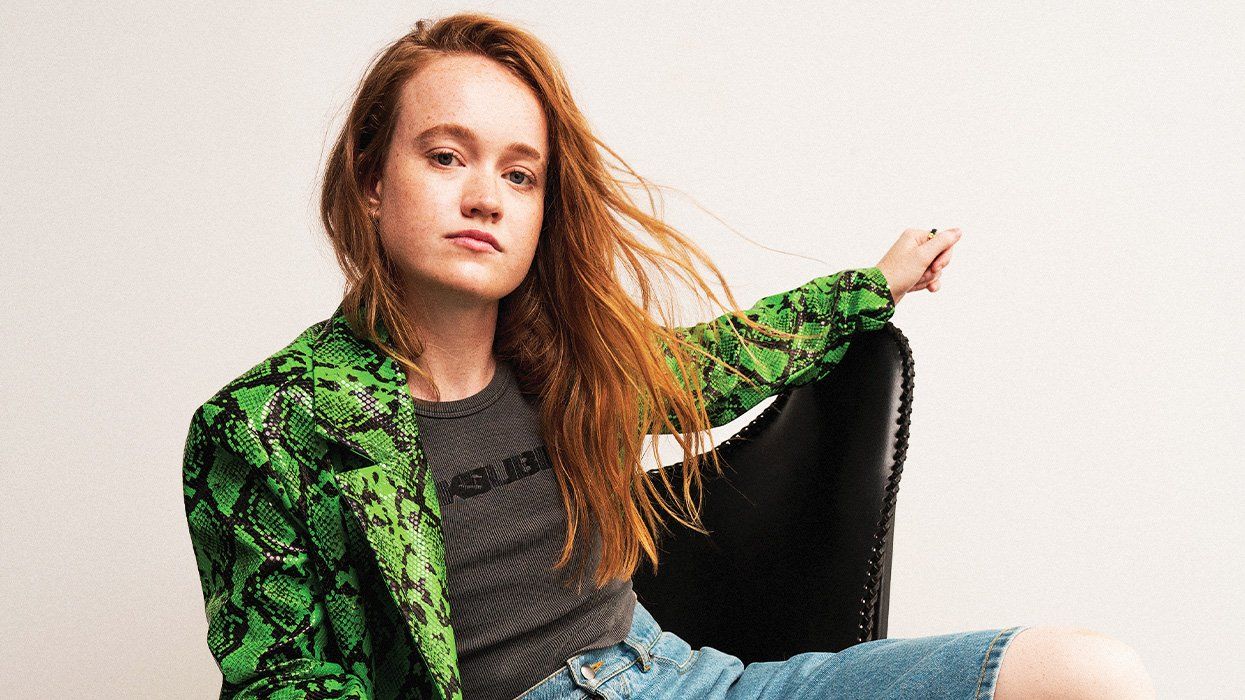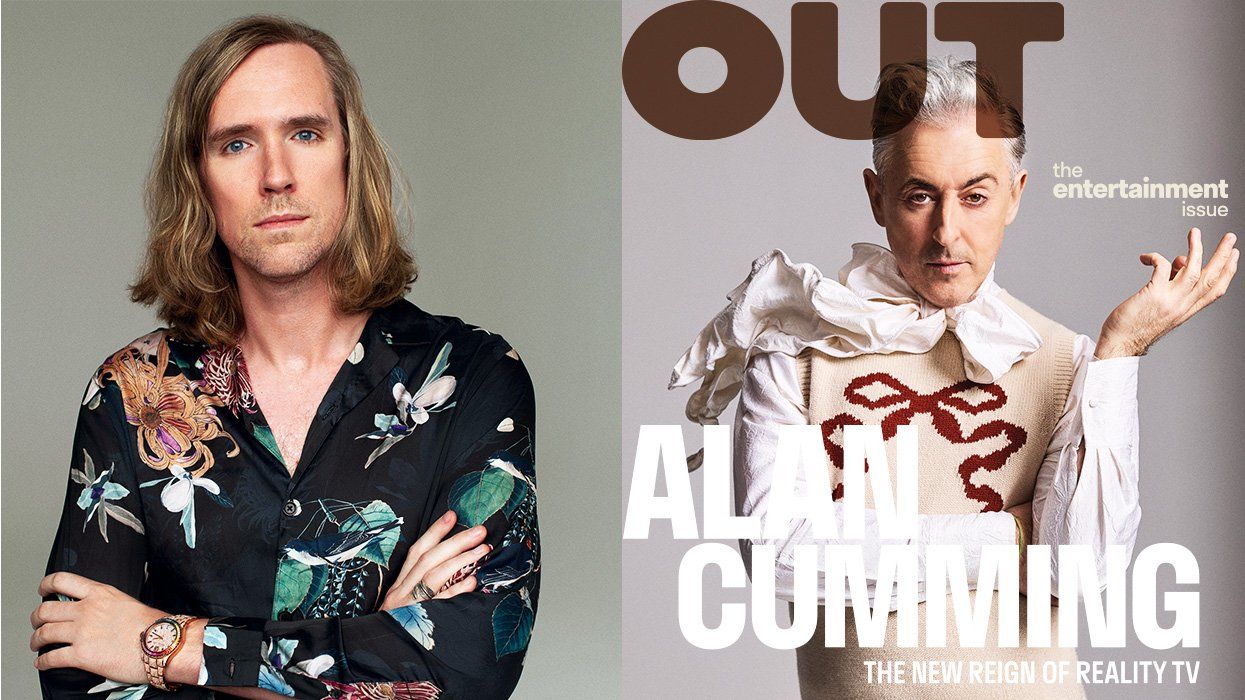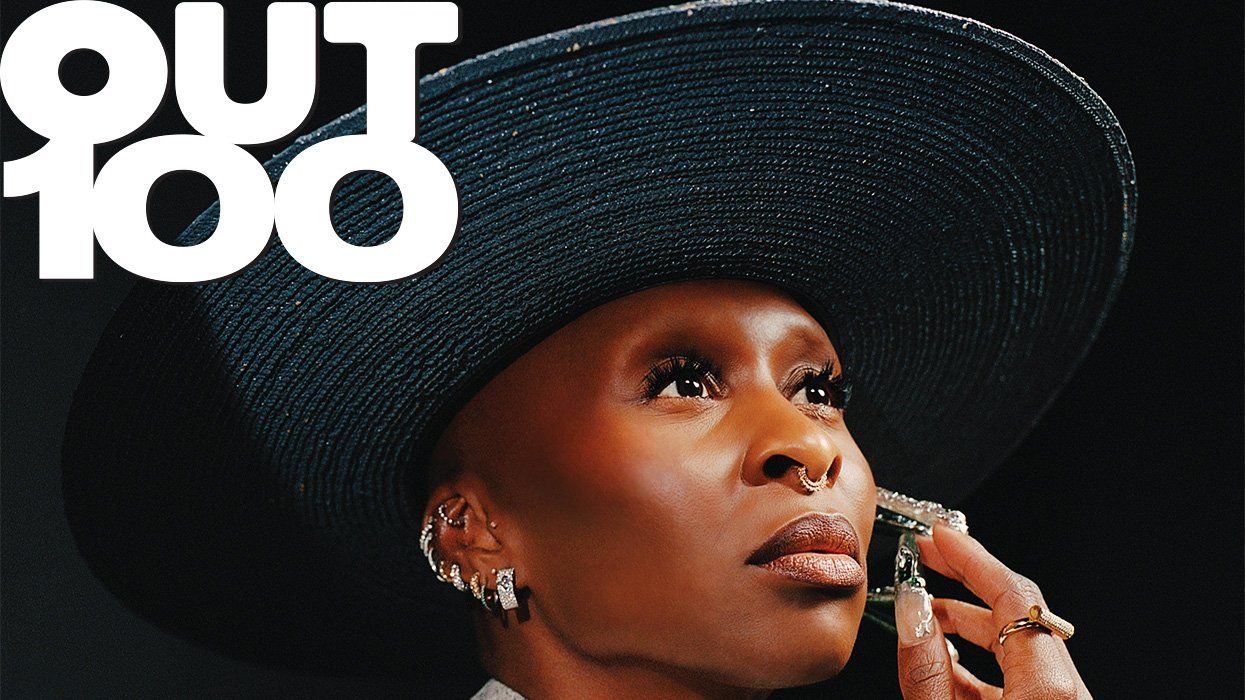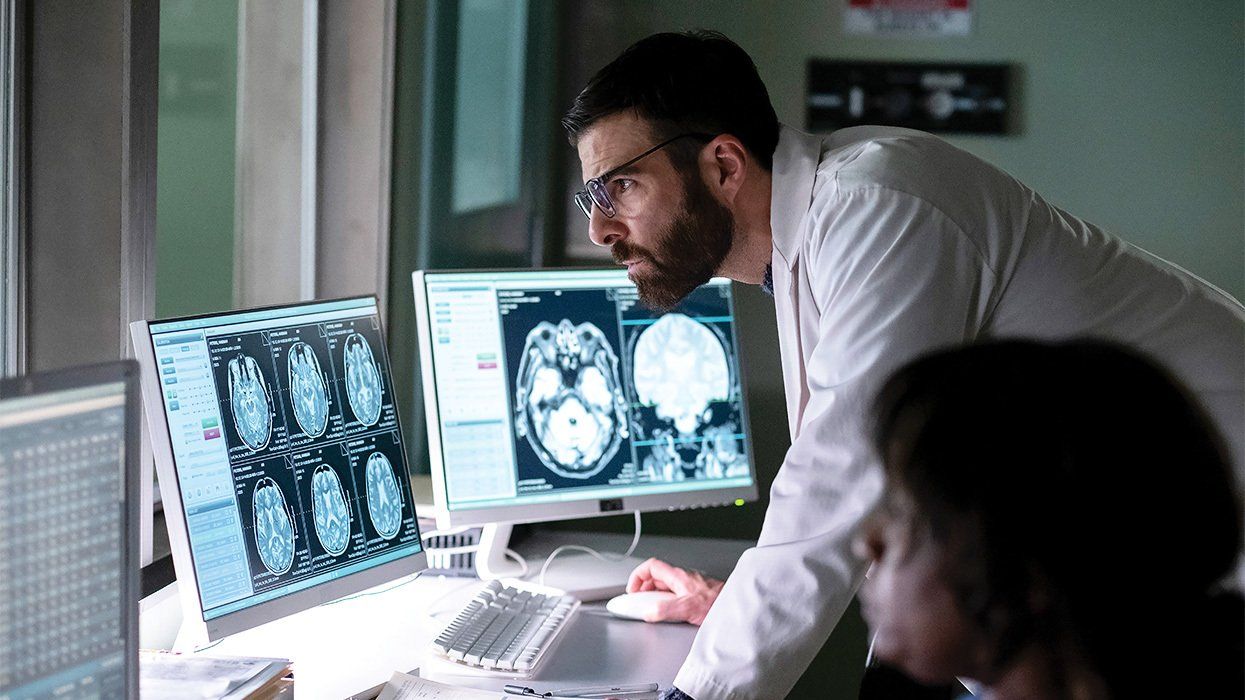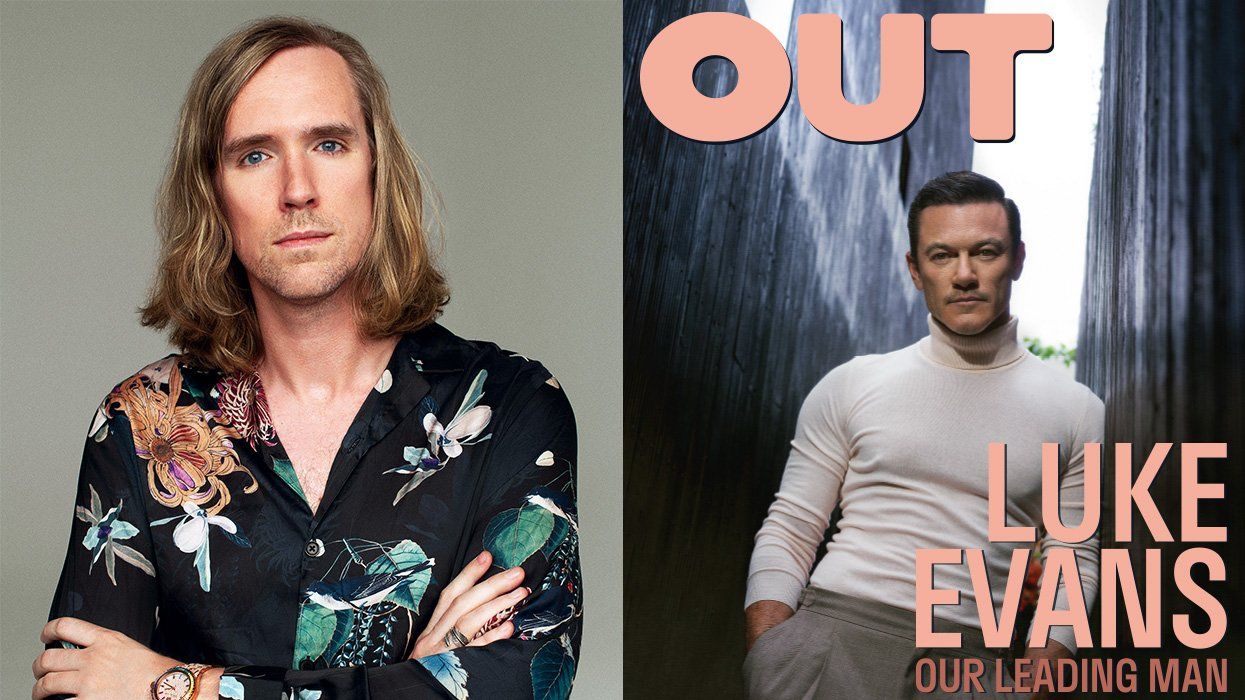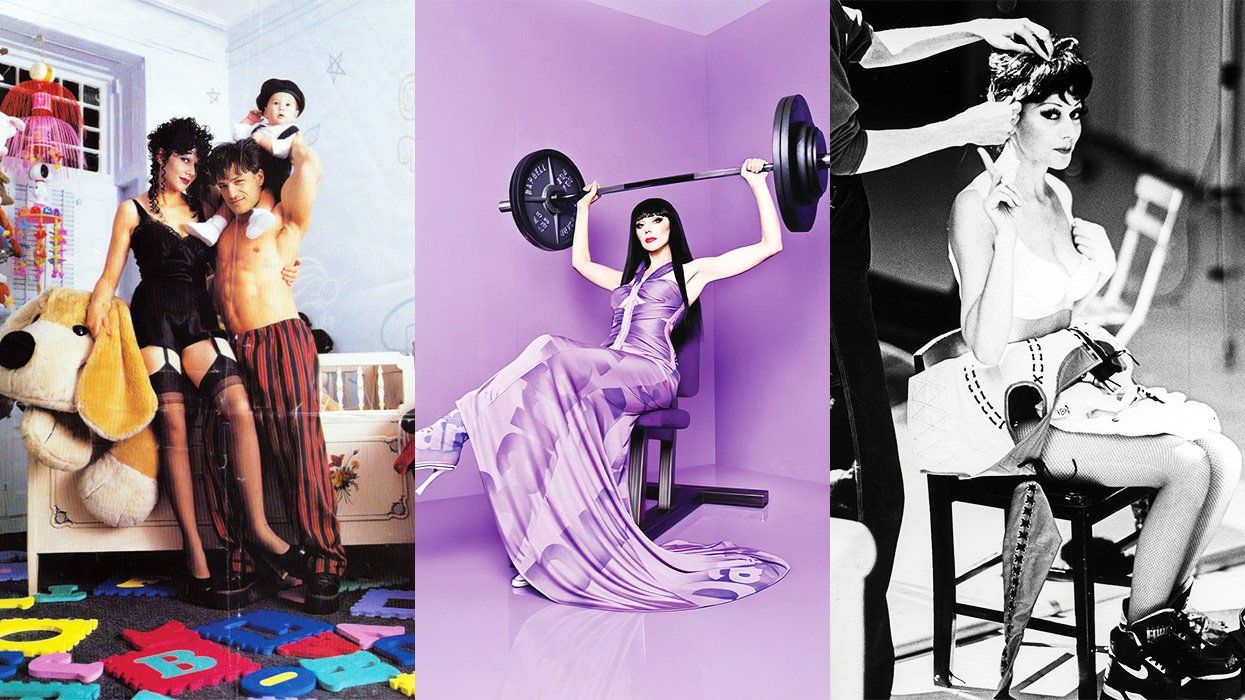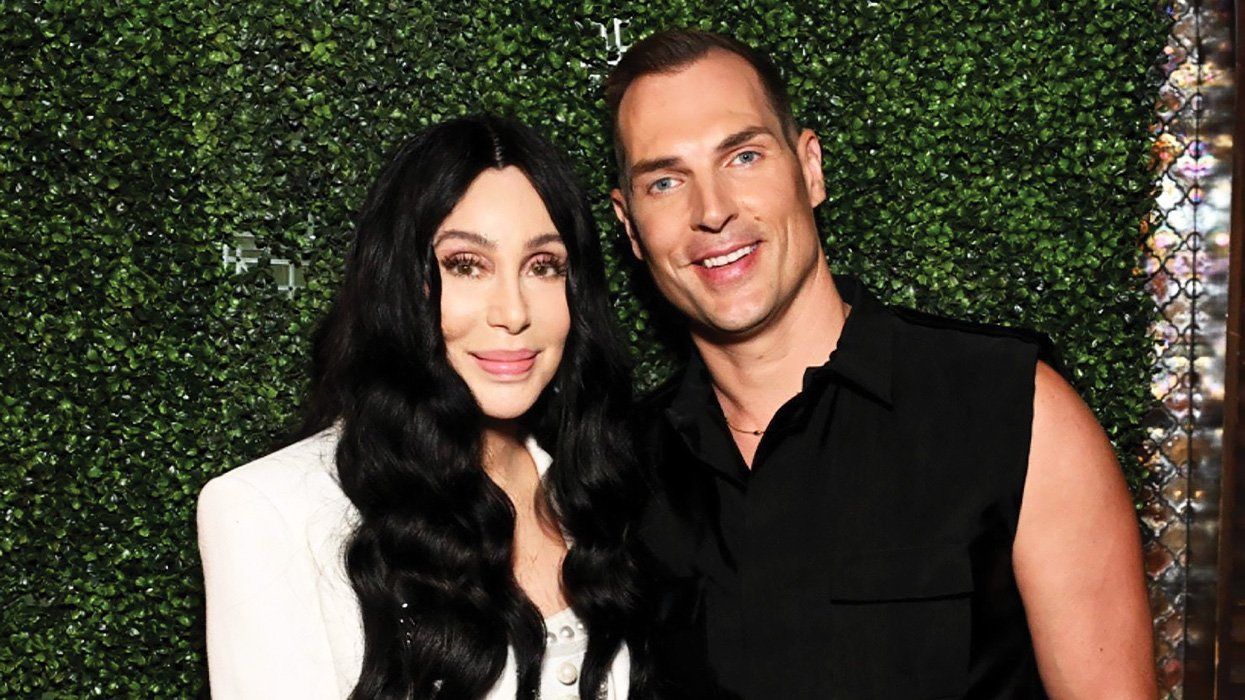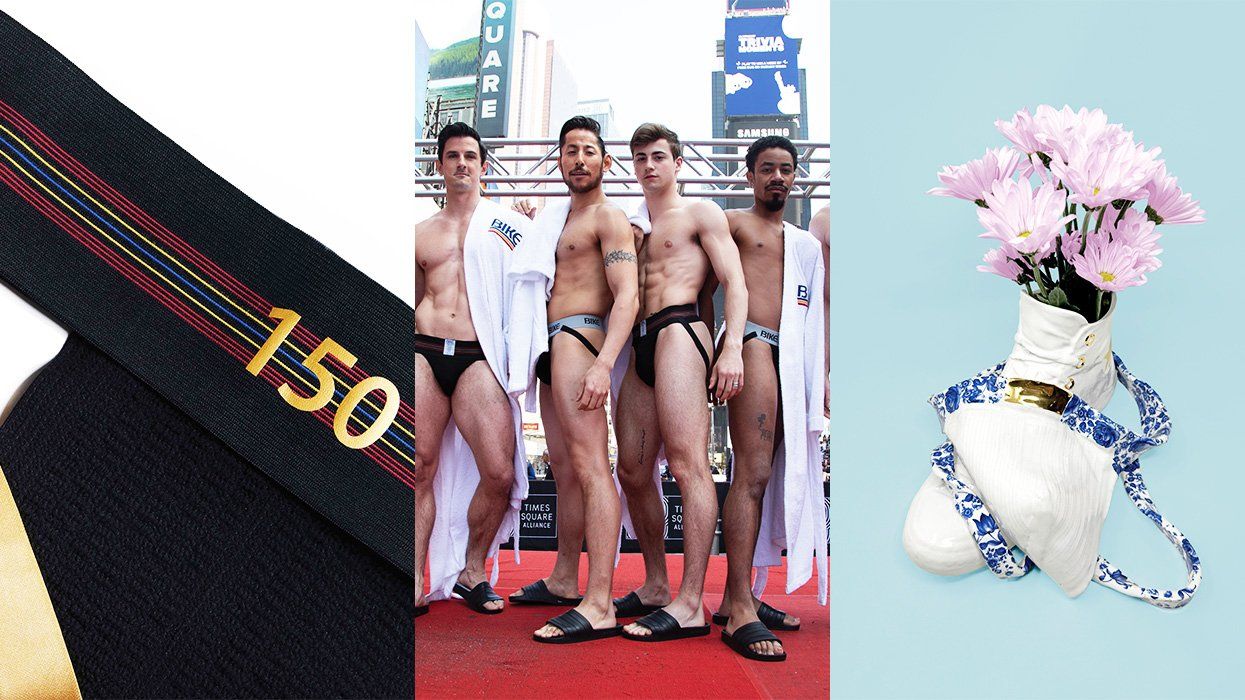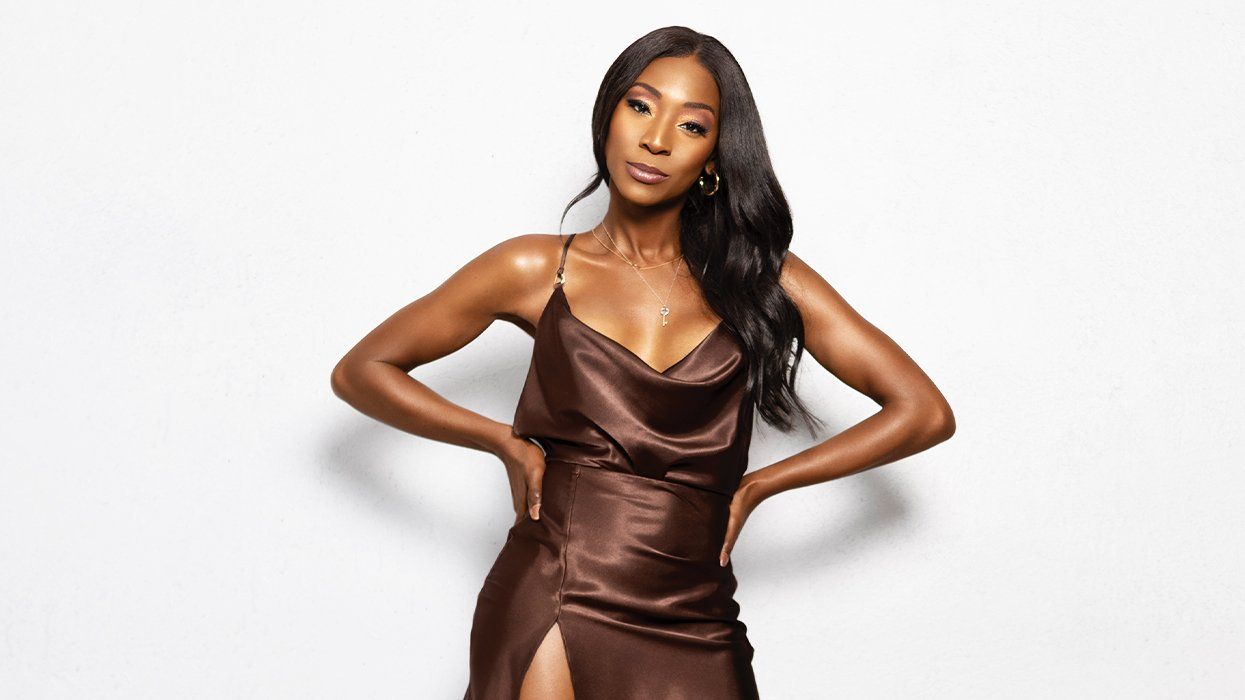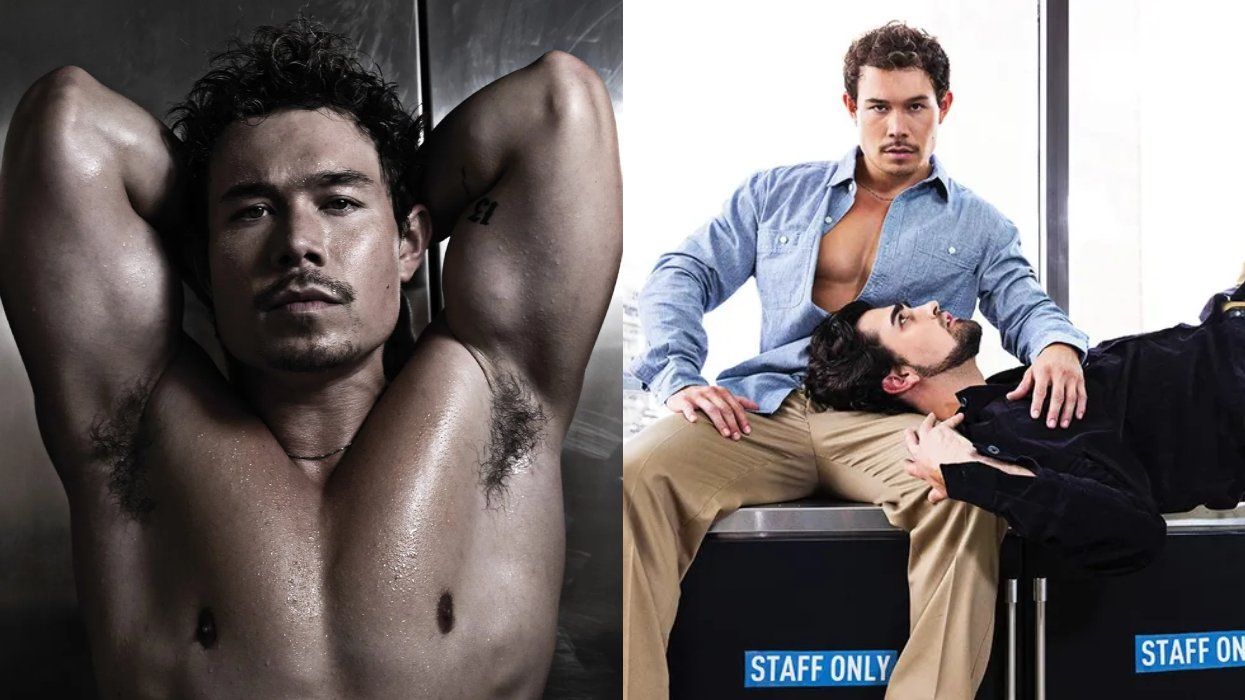Laverne Cox and Chella Man individually break barriers and shatter ceilings with every step in their careers. So, it's a slightly arresting moment to witness them both meeting for the first time. Though the Emmy-nominated actress best known for her role on Orange Is the New Black quite literally paved the way for the 21-year-old genderqueer model who made his acting debut in the DC Universe's superhero series, Titans, last year, the pair is surely far beyond what our transcestors (or transgender ancestors) could've imagined.
It's a sharp, early winter afternoon deep in Brooklyn when Man arrives at our joint cover shoot and greets Cox, who has been on set all morning, dancing to Beyonce and belting out operatic riffs as hair and makeup enhance her natural beauty. After some individual shots are taken in Man's first look -- a sage-green Miu Miu bustier and matching skirt--the time comes for the pair to pose together. Cycling through a number of poses, Man instinctually gets to one knee. Gazing up to Cox, he exultingly extends his arms in her direction, at once bowing to and reveling in her eminence. It's both corny and endearingly awkward, yet necessarily reverential. After all, he is one of the newest trans actors on the scene. I can't help but think that it's exactly what he should be doing because, to put a spin on Martha Munizzi's popular gospel hit, he was created -- as we all were -- to make her praise glorious.
Ironically, "glorious" is how Cox, 47, describes meeting Man to me a week later at the West Hollywood SoHo House in Los Angeles. "I could cry. I really could ... because I don't want to have children. But I kind of feel like these are my babies," she says of the new generation of visible trans folks in Hollywood more than half her age. For many of them, she's quite possibly the first trans person they saw on television.
"Not that I've even met them or whatever, but it's like, this is the dream. This has been the dream for me," she continues, fighting back the tears. "The only reason I did reality television is [because] I was consuming media years ago, [and when] I watched The Real World and Making the Band, I was like, 'What would it be like if a trans person were on here?' Now we are, and it's just glorious."
Pre-Transmission
Much ado has been made about the current increase in transgender visibility on and off screen, often ignoring, or at the very least not acknowledging, the troubled history of trans representation. Early trans characters were almost exclusively played by cisgender actors and often fell into the "cross-dressing killer" trope, as employed in Alfred Hitchcock's 1960 Oscar-nominated flick Psycho. (Because of a difference in the language of the time, "trans" wasn't often a term used to describe members of the community. "Cross-dresser" or "female impersonator" was more common.) Or they villainize trans identity, presenting it as a tool for manipulation,comedy based on Gore Vidal's 1968 novel of the same name, starred cis actress Raquel Welch as a trans woman who, after having gender confirmation surgery in Copenhagen, lies her way into the lives of a heterosexual couple that she breaks up. Myra ends up sexually assaulting the man and running over the woman before she wakes from the apparent dream as Myron. Then in 1994's Ace Ventura: Pet Detective, trans women are made to be vomit-inducing beings as, in one scene, Jim Carrey's Ace throws up after discovering the trans identity of a character he's kissed.
But it wasn't all bad. In a 1977 episode of Norman Lear's The Jeffersons titled "Once a Friend," Sherman Hemsley's George meets up with a former Army buddy who is now a woman named Edie, played by cis actress Veronica Redd. While not void of some cringe-worthy jokes, the episode is ultimately a positive portrayal, especially for its time. Then in a Clint Eastwood-directed drama, 1997's Midnight in the Garden of Good and Evil, adapted from John Berendt's nonfiction novel of the same name, trans actress and performer The Lady Chablis plays a version of herself (also present in the book) opposite Kevin Spacey and John Cusack. The role allowed her to become one of the first drag performers to be accepted by a mass audience.
At the turn of the century, Hilary Swank stormed onto film screens in the Kimberly Peirce-directed Boys Don't Cry, a dramatization of the real-life story of Brandon Teena. Playing a trans man who was beaten, raped, and killed by his male acquaintances after they discover his gender identity, Swank landed her first Oscar and became, for many, a notable, popular characterization of transmasculine identity. Then came a slate of trans characters of varying portrayals: 2003's Normal stars Tom Wilkinson as a Midwestern factory worker who comes out as trans and is supported by her wife (Jessica Lange); that same year, Showtime's Soldier's Girl told the true story of an Army man (Troy Garity) who was killed by fellow soldiers for dating Calpernia Addams (Lee Pace), a trans woman; and early and later episodes of Nip/Tuck featured stories like that of Avery Tanner/Ava Moore (Famke Janssen), a gay man who had a "sex change" because he was in love with a straight doctor (Alec Baldwin), or Alexis Stone (trans actress Candis Cayne), a woman seeking to reverse her transition because it's too hard to find men to date. There was also Felicity Huffman in 2006's Transamerica, playing a transgender woman who goes on a road trip with her long-lost son Toby (Kevin Zegers); and Max Sweeney (Daniela Sea) in the original The L Word, a bisexual trans man who becomes pregnant in the final season. Cayne would pop back up in 2007's Dirty Sexy Money as Carmelita Rainer, a trans woman involved with Billy Baldwin's Patrick Darling IV. Carmelita was killed off in a 2008 episode, but her death was unrelated to her identity, unlike so many trans characters before her.
Meanwhile, on the reality television side of the industry, a trans man received the Queer Eye treatment in 2006 (then called Queer Eye for the Straight Guy); contestants competed for the love of trans actress Calpernia Addams (including a trans man suitor, Jim Howley) in Logo's 2008, reality dating show Transamerican Love Story; and a younger Laverne Cox competed on VH1's I Want to Work for Diddy in 2008. Though Cox didn't win, the show was honored with a GLAAD Media Award, and she worked with the network to star in and produce the 2010 makeover reality series TRANSform Me with trans co-hosts Jamie Clayton and Nina Poon.
Trans representation, unscripted and otherwise, continued in small ways after this. Isis King had a stint on America's Next Top Model in 2008. Cis actress Jordan Todosey played Adam, the first trans character on Degrassi: The Next Generation in 2010. And in 2011, Harmony Santana became the first openly trans actress to be nominated for a major acting award in the United States -- an Independent Spirit Award for Best Supporting Actress for her role in the 2011 Rashaad Ernesto Green-directed Sundance breakout Gun Hill Road. All of this culminated in a major moment for the community: Chaz Bono, the child of entertainers Sonny Bono and Cher documented his transition in the film Becoming Chaz, which aired on the Oprah Winfrey Network in May 2011. In September of that year, he became the first openly trans man to star on a major network television show for something unrelated to being transgender, as a contestant on the 13th season of Dancing with the Stars.
Drawing the Curtain
At 41 years old and 15 years into her transition, Laverne Cox re-emerged in 2013 on a new show titled Orange Is the New Black on Netflix, playing Sophia Burset, a trans inmate who committed credit card fraud to fund her transition because medical insurance would not cover it. Cox's visibility and activism as one of the then-estimated 1.5 million trans Americans landed her on the cover of Time a year later with the publication deeming the broader socio-political moment "The Transgender Tipping Point."
"Almost one year after the Supreme Court ruled that Americans were free to marry the person they loved, no matter their sex, another civil rights movement is poised to challenge long-held cultural norms and beliefs," Katy Steinmetz wrote in the June 9, 2014, issue. "Transgender people ... are emerging from the margins to fight for an equal place in society. This new transparency is improving the lives of a long misunderstood minority and beginning to yield new policies, as trans activists and their supporters push for changes in schools, hospitals, workplaces, prisons, and the military."
"It's wild to me thinking about this magazine cover," Cox tells me now, as she sips some hot tea. Prior to the Time cover, affirming trans representation in print was limited. There was, for example, actress Ajita Wilson who, in 1981, appeared in the once-prized Black magazine, Jet, as a "Beauty of the Week" and Caroline "Tula" Cossey, who had a Playboy pictorial in 1991. But the visibility of trans folks was nothing like it is now.
"When Orange happened, I didn't realize it would turn into what it did," Cox continues. "So, my whole thing was how do I use this moment to build a brand that goes beyond Orange Is the New Black? Doing I Want to Work for Diddy got me thinking about myself as a brand in a way that I would not have if I had not done reality TV."
Before her big break, Cox worked at Lucky Cheng's, a restaurant known for its dinner shows, on New York's Lower East Side. Though she had applied to be a waitress, she ended up performing as a drag queen, a space that became an outlet for her love of performance. So, in a way, she was ready for the attention that was finally coming her way after years of acting training and background work. But she wasn't prepared for the critique that came with being seen as a spokesperson for the entire trans community, she remembers.
"It was really stressful because that part is new and there's no amount of acting classes or life experience that can prepare you for that level of responsibility, pressure, and criticism, not just from right-wing people writing articles misgendering you, but also from your community itself," she says. "I think what was weird for me is I never thought of myself -- I thought I was cute, but I didn't think I was, you know, [a cover star]. Then all of a sudden I became this beauty standard."
She says it was "weird" and "hard to hear" that she was "drop-dead gorgeous" and worthy of being on magazine covers, a fact that caused its own ire from within the trans community as her star rose, while at the same time being "misgendered and called a man" on the street.
"There's the trauma of all those lived experiences and then the responsibility of being literally thrust on the cover of Time magazine like, 'You represent this community,'" Cox says. "And while you can go back and see me say in interviews, 'There's not just one trans story; There's an entire community,' I don't know if people were really fully hearing it. I was very cognizant to try to lift up other trans people at the time, but at the same time, I was the one on the magazine covers."
An unfortunate byproduct of the moment then was an erasure of a history of trans people that had come before her, in Hollywood and beyond. "It's just the truth that I wouldn't be here if it were not for her," Cox says of trailblazer Candis Cayne, for example. "That is the literal truth. I would not have believed it was possible. I wouldn't have the manager that I have now, that I've had for 12 years, if it weren't for Candis Cayne."
Or for the likes of Alexandra Billings, Jazzmun Crayton, Sandra Caldwell, Ajita Wilson, Aleshia Brevard, and Candy Darling before Cayne. "But we just don't know those stories," Cox continues. "Thinking about this moment now, it's like we're on the shoulders of people who couldn't disclose, who couldn't be openly trans, who endured a lot worse. I've always wanted to acknowledge that, that we know this isn't the beginning of all this."
New Beginning
For about a year after the Time cover, Laverne Cox was perhaps the most famous trans person in the world. She toured the country over, sharing how her humble Mobile, Alabama, beginnings made her into the woman she always knew she was. Meanwhile, in Mechanicsburg, a small town in central Pennsylvania, Chella Man, then a 15-year-old high schooler, was pulling off a stunt of his own.
"I was performing my greatest performance of all, which included stereotypical femininity and trying to blend in," he says over a latte on the Lower East Side days before the cover shoot.
"I was trying to figure out how to live in a world where I had to lie about my true self, and simultaneously be happy and okay with that. I was repressing my sexuality and gender, trying to figure out how to navigate growing up and educating myself in a space that wasn't designed for a Deaf person to learn in."
And he couldn't truly turn to pop culture for a glimpse of what freedom and acceptance could look like for him due to his many marginalized identities. In addition to being Deaf, Man is Jewish and Chinese, trans, and genderqueer. Though he found bits and pieces of himself -- in the Freeform series Switched at Birth that ran from 2011 to 2017, in superstars like Nyle DiMarco and Christine Sun Kim, and on social media--it was hard to see his lived experiences reflected back to him.
Unaware of what was unfolding in the broader community regarding trans visibility, he found solace in art. On reflection, Man remembers drawing "all of these androgynous figures [while] crying," which reflected his emotional state at the time. "Because I didn't have the language to explain any of those things I was struggling with, I would try to draw them, but in a way where, if I drew them, it wouldn't give away my secret," he continues. "People could enjoy the art but also not really know anything at all, because I didn't even know what I was trying to say. I didn't even at the time consciously know I was trans, because I didn't have the words."
And it didn't help that the art classes at his school weren't a nurturing environment. He remembers almost failing art class because "I had a teacher that really hated me and was really ableist, and would call on me randomly during lectures even though she knew I couldn't hear what she said," he says. She'd then shame him in front of the class even though she knew he used a cochlear implant.
Outside of school was no better. Man lived in a deeply conservative area and notes that then reality television star Donald Trump held a rally at his high school leading up to the 2016 presidential election.
"That was one of the worst nightmares I've ever had to live through because it's a small town, and so all the kids that I grew up with, people that I knew for almost 17 years, I just watched them walk by, not look at me, not make eye contact, and just walk into that building," while he was outside protesting with a small group, he says.
The world around him was so oppressive and draining that he found himself waking up, going to school, and coming home to get straight in the bed. "I just wasn't living, I wasn't enjoying myself, and I felt really depressed, and so I had to get out," he says.
After working hard academically, Man was poised to graduate high school as a junior. Luckily his mom recognized her child's need to get out of their community and she helped him apply to an early college acceptance program at Parsons School of Design. Moving to New York City set him on a path toward liberation and happiness.
Once in the big city, Man began formally -- to borrow the title of the TEDx Talk he'd later give in May 2018 -- "Becoming Him." He created a YouTube channel on which he documented the varying stages of his transition, educating the now-249,000 subscribers on gender dysphoria, the effects of hormone replacement therapy, and what it means to be genderqueer. He also included videos of himself performing American Sign Language to popular songs as his audience grew on the video platform and across other social media (now over 700K total followers). In September 2018, he signed as a model with IMG and has since been featured in campaigns for Calvin Klein, Gap, and American Eagle, among others. What a rise for someone who was struggling just to get out of bed not even five years ago!
"My voice is now heard, and I'm able to be my own representation," Man says about his visibility. "It's been a huge fucking privilege, and it's been absolutely amazing. I'm continuously learning so much about myself while being that person I wish that I had when I was younger."
Generation Now
The importance of Laverne Cox's role on Orange Is the New Black, for which she became the first trans actress to be nominated for an Emmy (now three times over), can't be overstated. While many look back on it and the Time cover with skepticism today, it unequivocally changed things in Hollywood.
"Prior to Orange Is the New Black, what people learned from film and TV was that of false, inaccurate, really twisted and distorted ideas about who transgender people were from these mostly poorly written films and TV shows," says Nick Adams, GLAAD's director of transgender representation. He's been with the media monitoring organization since 1998, working to improve how trans characters are cast and written.
"What I saw was that immediately after its premiere--and after people got to see the way Sophia Burset was written, and the way Laverne Cox was able to play her with such authenticity, depth, and humor--the overall conversation changed, [as well as] the types of requests that I was getting for consulting and help creating better transgender characters," he continues. He notes that another shift happened just months after the Time cover with the premiere of Jill Soloway's Transparent on Feb. 6, 2014.
The Amazon Prime original, based on Soloway's life, followed a family as they adjusted to one of their parent's gender transition. Jeffrey Tambor played Mort who becomes Maura opposite a cast that included Gaby Hoffmann, Amy Landecker, Jay Duplass, and Judith Light. The show was an instant critics darling, nabbing Golden Globes and Emmys. It placed Tambor, who is cis, at the center of conversations about trans storytelling while highlighting the show's "transfirmative-action" hiring philosophy that ensured trans people were employed at every level of production. Silas Howard benefited from this effort, becoming the first trans person to direct an episode of the show in the second season and two more in the third season, a gig he says single-handedly changed the trajectory of his career. Even though he had directed his first film, By Hook or by Crook, in 2001, he was working for and in community before Transparent gave him the access he needed to tell queer and trans stories on larger, less independent scales.
"I was given a break in which I could prove myself and I was able to show on that show what I could bring to it," he says. Howard has since gone on to direct a number of films and episodes for This Is Us, The Fosters, Pose, and Tales of the City.
Following OITNB and Transparent, bookending perhaps the most pivotal time period to date for trans representation, was Caitlyn Jenner's coming out in April 2015. "Those things together were kind of a perfect storm of cultural conver sation around what it means to be a transgender person," Adams says, "and Hollywood was paying attention to all of that and starting to really want to figure out how they could change and do a better job of telling transgender stories and writing and casting transgender characters."
But Sam Feder wasn't convinced that this seemingly significant increase in visibility of trans visibility was positive on the whole. He's a filmmaker who's dedicated his career to documenting the lives of trans folks who says he "actually kind of felt a punch in the gut" at the time.
"I felt more scared than excited," he says. "I was really confused because I thought, all this time, having representation and good representation, which was what we were starting to see, was what I was working towards, but something felt really wrong and amiss."
He took issue with the concept that trans people "had just emerged" because such framing wasn't reflective of our lived experiences. "We were erasing the people that had come before, and it was covering up the real vulnerabilities that trans people on the street were facing," he continues. "And it was putting us in harm's way and commodifying our identities. It was [because of] the framing of that moment in 2014 that I knew it was not going to turn out well for people on the street in the way people thought, because we know when any marginalized community enters the mainstream, backlash ensues."
That when Feder's filmmaking instincts kicked in and he started working on his latest project, Disclosure: Trans Lives on Screen, a 100-minute documentary that premiered at Sundance this year. The film -- an effort to get audiences to be more active consumers of media and to chart how Hollywood both reflects and produces society's deepest anxieties about gender -- was executive produced by Cox and features interviews with Lilly Wachowski, Yance Ford, Mj Rodriguez, Jamie Clayton, and Chaz Bono, among others, and is the first of its kind. And as expected, in the years since Feder began working on Disclosure, a backlash of sorts to trans visibility began.
According to the Equality Federation, over 200 anti-LGBTQ bills, including those focused on public accommodation exclusion and "religious exemption," were introduced in state legislatures across the United States in a year's time. There were local protests and petitions against trans athletes playing on high school teams reflective of their gender, as shown in the doc Changing the Game. And, on the federal level, Donald Trump took office and his administration swiftly withdrew a landmark 2016 guidance explaining how schools must protect transgender students under the federal Title IX law, made efforts to discharge and ban trans people in the military, and began arguing that federal law does not prohibit discrimination against trans people based on our gender identiity.
Thankfully, Disclosure grapples with it all, perfectly timed as trans visibility continues to balloon.
"It's really about trans spectatorship," Cox says. "Every single person on our screen is trans, and so it's about how we look, how these images shape how we see ourselves, and how they shape how people treat us...I think knowing the extent of it will help give us perspective on where we are now, and why people have treated us the way they have for so long, and then begin to chart pathways for undoing that. For non-trans people, I hope they'll understand all of the implicit biases that they have, based on media representations, and begin to think differently about who we are."
Almost three years had passed after the premiere of Transparent before another defining moment in trans representation on screen took place. It was much needed, as Soloway's show became mired in controversy, namely the sexual misconduct allegations lodged at its cis lead by at least three trans women who worked on the cast and crew. It was also time that trans people were centered in the telling of our stories. Insert Pose, the Steven Canals-created, Ryan Murphy-championed series about life in the 1980s ballroom scene.
Long before the June 2018 premiere date for Pose bowed, the show had already made history for assembling the largest trans cast ever on television at over 50 people. Additionally, the main cast starred five trans women and nonbinary people of color in recurring roles (Mj Rodriguez, Dominique Jackson, Indya Moore, Hailie Sahar, and Angelica Ross) and added journalist-turned-author Janet Mock to its writers room (along with Our Lady J).
"I remember when Janet came out," Cox recalls, calling it a "tectonic shift, particularly for Black trans people, even moreso than [when I was on Time]. She just embodied so much of the fantasy that I wanted when I transitioned. Because when I started in 1998, I didn't transition to be an openly trans woman. I transitioned to be stealth, because that was what we did in 1998, and that Janet was able to do it, and then chose to come forward and be this beacon for the community was so huge for us at the time."
Mock would emerge the first trans woman of color to write and direct any episode of television, season one's "Love Is the Message," and last year, she became the first trans woman to sign an overall deal with a major studio (Netflix). But this was, and is, just the beginning of the post-Pose world.
Each of the main cast, some who had little acting experience prior to the show, have spun the opportunity into other acting gigs. Rodriguez starred in the Pasadena Playhouse edition of "Little Shop of Horrors," Moore landed a role in Lena Waithe's Queen & Slim, and Ross became the first trans actress to secure two series-regular roles after she parlayed the death of her Pose character into a role on Murphy's latest American Horror Story installment, 1984, and representation continues proliferating throughout the industry.
In 2019, actress and model Leyna Bloom stormed through the Cannes Film Festival as the first trans woman of color to lead a film (Port Authority) premiering there in its 72-year history, Trace Lysette rebounded from the Transparent debacle opposite Jennifer Lopez and Constance Wu in Hustlers and Hunter Schafer stole hearts as Jules in the Drake-produced television drama Euphoria to name a few instances of recent representation.
But where previous flashpoints of increased visibility have mostly centered on trans women and trans femmes, trans men and transmasculine folks are now decisively entering the conversation. Paving the way has been Brian Michael Smith, who in 2017 disclosed his trans identity through a role in the second season of Ava DuVernay's OWN series Queen Sugar, after almost six years of acting in non-trans roles. It was a long time coming, he says,
that only presented itself as potentially possible after he saw Cox's "fully fleshed out, well-written role that was not a trope of a trans person or someone still exploring their transition" in OITNB. Then Cheryl Dunye's short Black Is Blue, which stars Kingston Farady as a Black trans man who works as a security guard inside an apartment complex in Oakland, California, made him feel like such a part was possible for him, too. The Queen Sugar opportunity would come years later through a referral from Howard, who had worked with Smith at the Tribeca Film Institute.
"He had posted on Facebook, 'I'm trying to help a friend cast for this role. We're looking for a Black trans cop.' I'm like, 'Oh snap, that's me!'" Smith remembers, having played officers on other shows. "Then I read the character breakdown and my jaw hit the floor because here was this self-possessed character giving advice to his best friend, and also expressing gratitude for the allyship that he gave to him back in the day, that he didn't get a chance to do before."
It was a fully realized, Black trans man character and the kind of character exploration he was looking for in a role. "And it was the perfect opportunity to come out publicly within my work," he continues. "I wanted people to know that I am available to tell these stories, I do have the experience, and I can play any kind of character, but I am interested in these kinds of stories when we are looking at things with a certain nuance."
When Murphy's latest project 9-1-1: Lone Star premiered in January, Smith became the first Black trans man in a series regular role. He helps lead the way for a slate of narratives featuring trans men and transmasculine folks, along with Elliot Fletcher (The Fosters), Leo Sheng (whom Smith co-stars with on The L Word: Generation Q), and now a popular model on Instagram named Chella Man. It's about time, says GLAAD's Adams.
"For many years I've talked about the invisibility of transgender men in mainstream media and the implications that that has for young transgender boys who are growing up looking to see themselves somehow reflected in the media and see nothing, which makes them feel like there's really no place for them in the culture," he says. "So, while it's incredibly important that we continue to tell the stories of transgender women and transfeminine characters--because trans women are subjected to the worst sort of transphobia and discrimination that this culture perpetrates on transgender people--it's also important that we tell more stories about transgender men and nonbinary people so that the full diversity of our community can be represented."
The Forecast
As it rains cats and dogs outside, Chella Man tells me that he never foresaw an acting career, but was always curious. When he got a random text from a friend, Lauren Ridloff, who starred on Broadway in "Children of a Lesser God," about a casting call from Warner Bros. for "either a half-Latinx or a half-Asian person that is also Deaf or hard of h earing and/or knows sign language," it was as if the cosmos were aligning for him.
"I really didn't expect anything out of it, but I was very curious about what auditions were like," he says. "I went in, auditioned, and really enjoyed myself because I've only now really solidified my gender identity and know who I am, so it was really interesting to find and push my identity to play someone else. I felt like I stepped in the shoes of someone else, but at the same time, I just accentuated parts of myself that I already had."
After getting a callback, Man eventually landed the role of Jericho on the DC Universe superhero series, Titans -- his first-ever. He says the entire process was "unreal," especially getting the call after he told them on his first audition that authentic casting was paramount, as the role was for a mute character.
"The first time I went in, which maybe wasn't the best idea because I wasn't really in a place of power in that moment, I was like, 'If you don't cast me, you need to cast someone else who is disabled. You cannot give this to a hearing person,'" he says. After leaving, he thought to himself that the casting directors "might be really annoyed that I was asserting my power, but that's the right thing to do."
And just like that, he became an industry advocate like the trans men, women, and people that came before him. As his profile continues to grow, now adding "actor" to a long list of titles, he says the greatest lesson he's learned about being visible involves divorcing his personal worth from all of the work he does.
"I was struggling a lot with feeling like I was worth what I gave out, and someone close to me recently told me, 'You are not what you give,'" he says. "It's such an old, cheesy thing that you could read in that horrible Comics Sans typeface on the wall of some woman's kitchen, but I realized I don't have to post every day to feel validated. I don't have to continue getting jobs to feel like I'm good enough. I can find validation for myself."
Man put this into practice by monitoring his personal thoughts and pulling away from social media and work when he begins "toxically thinking about the ways I push myself or put out content," he says, which means "taking a break from everything." As such, he's been turning down a number of opportunities, deciding instead to take on an artist residency in Italy, a move one might not expect a young upstart like him to make at what some would say is the highest point in his career thus far.
"I've researched deeply what happens to visible people once [their fame] skyrockets, and the answer is often that they became unhappy," Man says. "No one was actually where they wanted to be and everyone felt disappointed. So, in this moment where people would say I should be taking [these jobs] because now is the moment to take them, I think by taking a break, I'll sustain my own happiness and who I want to be at my core."
Still, he knows that there's a utility in his visibility, even if it's mainly on social media for the immediate future.
"I think we have a lot of work to do around the gender binary and dismantling it," he says about conversations to which he hopes his presence contributes. "A lot of times people forget that I identify as genderqueer because the way I present myself is so stereotypically masculine. But I want to use my appearance to remind people that, although I appear one way, I'm still nonbinary, and please don't forget that. If you really respect me and my work, you won't forget who I really am, and you won't misgender me...I can't wait until the day that people just talk about people, whether they're transmasculine or transfeminine because it doesn't matter anymore. That would be a huge step."
Such a step is on the horizon if not already in progress, as more nonbinary and gender nonconforming people come out of the margins, such as actors Asia Kate Dillon (Billions), JayR Tinaco (Another Life), and Theo Germaine (The Politician) and writers Jacob Tobia and ALOK, among others.
Back at the SoHo House, about an hour into our conversation, I tell Cox that I feel like she doesn't get her due. What with the successes and headline-garnering blunders of Caitlyn Jenner, Transparent, and now the women on and around Pose, it seems to me that the pivotal role she played in our community's visibility is old news.
"I just feel really lucky that I'm still here, that I'm still working," she slyly says, because we both know how fickle the industry is toward Black women and women of a certain age. "None of this is guaranteed. I'm fine. I'm actually more than fine in terms of me 'not getting credit.' The credit is Chella Man. The credit is Hunter Schafer. The credit is Asia Kate. It's Mj Rodriguez. It's Indya Moore. That's what it's about. None of this was ever about me -- and I'm not trying to do humble bragging or anything. This is about an inevitable moment that had to happen, and I was a vessel for it. As a vessel, you move out of the way and let it do what it's going to do."
She pauses, reaching for her teacup, before relaxing back into the pink tufted cushion of her chair.
"I'm a first for a lot of reasons, right?" she continues. "Before I did it, it had not been done by a trans person before. That's lovely, and it's amazing, but when I got the Emmy nomination this year, it hit me that I'm still the only one in a year of shows like Pose. That's not progress. Being the first and only is not doing anything, really. It's like you have to actually open the door and other people [have to] walk through. That is progress. That is the victory."
Cox says she's just "grateful" that Rodriguez can, for example, "do a daytime or late night talk show and not have fucked-up questions asked," like she, Mock, and model Carmen Carrera had to do just five years ago.
"Girl, I'm really proud of that, and if people forget that there was a moment when that shit happened, then maybe that's progress too," she says. "Everybody wants to be remembered and acknowledged. I certainly do, but the accomplishments are there. I'm onto the next thing, and I'm trying to stay relevant now. I can't be harping on what I did five or six years ago and people not giving me the credit I deserve."
As for what she has coming up -- she stars in Justin Simien's Bad Hair and Emerald Fennell's Promising Young Woman, both of which premiered at Sundance earlier this year, and the Shonda Rhimes-created Inventing Anna hitting Netflix later this year -- Cox is focused on "the next battle we have to fight," she says.
"I'm thinking about how do I want to contribute to the election conversation," she says. "And I'm not sure yet, because I don't want to be a tool of this partisan, at your throat, tribalism stuff. People de facto put me there because I'm Black and trans and I want trans people to be treated with dignity... but I don't want to contribute to the tribalism and the us-versus-them narrative that's so divisive right now."
She makes a point to say she's a registered independent, "but, to be clear, I'm not anywhere near Republican," before revealing that she wants Senate Majority Leader Mitch McConnell voted out.
"I said to my team, 'We need to carve out space in my schedule for me to go to Kentucky and campaign for whoever is running against Mitch McConnell,'" she says. "Then I thought about, 'Do they even want me in Kentucky? Do they want to hear from this Black trans woman -- a Hollywood elite in their minds -- in Kentucky? Is it safe for me to go to Kentucky? Do I need security? Do you know what I mean?'" I nod in agreement.
But is that the best use of her time and platform? She's still figuring that out. As for her moves in Hollywood, she says it's about time she takes greater control of her career.
"I've been lucky over the past few years that the reason people know me is because of Orange Is the New Black," Cox says. "I also have a brand that's independent of me as an actress, so I'll go and do other things to make money, but ultimately I want to act and I want to tell stories where the personal and the political come together. That's what I'm most passionate about."
She tells me of several projects she's got in development (with Lifetime and Comcast), attached to them as a producer and an actress, that combine her love of history and politics. "There's a number of irons in the fire right now," Cox hints. "One of them has to spark."
Meanwhile, the broader industry still has work to do. Taking an honest look at trans visibility, as much as there are some celebrations to be had, we're still at the stage where casting trans folks is a novelty. Behind the scenes of the writers rooms that have trans people -- most have none to our knowledge -- many only employ one trans person. (Pose is a notable exception with two.) And the opportunities for more trans directors to bring their excellence to projects are still very finite. In effect, such nominal inclusion is tokenism by another name.
"If you only have one voice in the room, that's not enough," Howard says. "One voice is bullshit [because] you're just there for checking their box and you don't really have any power."
Therein lies the next step for an industry that verbalizes a commitment to reflecting our worlds as they are and as we wish them, relinquishing meaningful power to the most marginalized. What does that look like? A trans woman of color leading a major Hollywood studio. A nonbinary or gender-variant person as the top-billed actor of a broadcast drama. A trans narrative exclusively starring and written, directed, produced, and funded by trans and gender nonconforming folks. T4T to the max.
A wild dream? Probably the wildest.
Photographed by Camila Falquez
Styled by Yashua Simmons
Hair by Bradley Irion using Kevin Murphy.
Makeup by Deja Smith at The Criterion Group, Inc
Nails by Eri Ishizu at Opus Beauty using Christian Louboutin
Grooming by Kiyonori Sudo at L'Atelier NYC using R+Co
Tailoring by Yana Galbshtein
Photo assistants: Rachel Kessler, Albert Font Garcia
Grooming assistant: Aya Iwakami
Fashion assistant: Julian Mack
Studio: Vandervoort Studio
This piece originally appears in Out's Culture Issue, available on newsstands on 2/25. To get an advanced look at the issue, download it for Kindle or Nook, and grab your copy by subscribing now.


